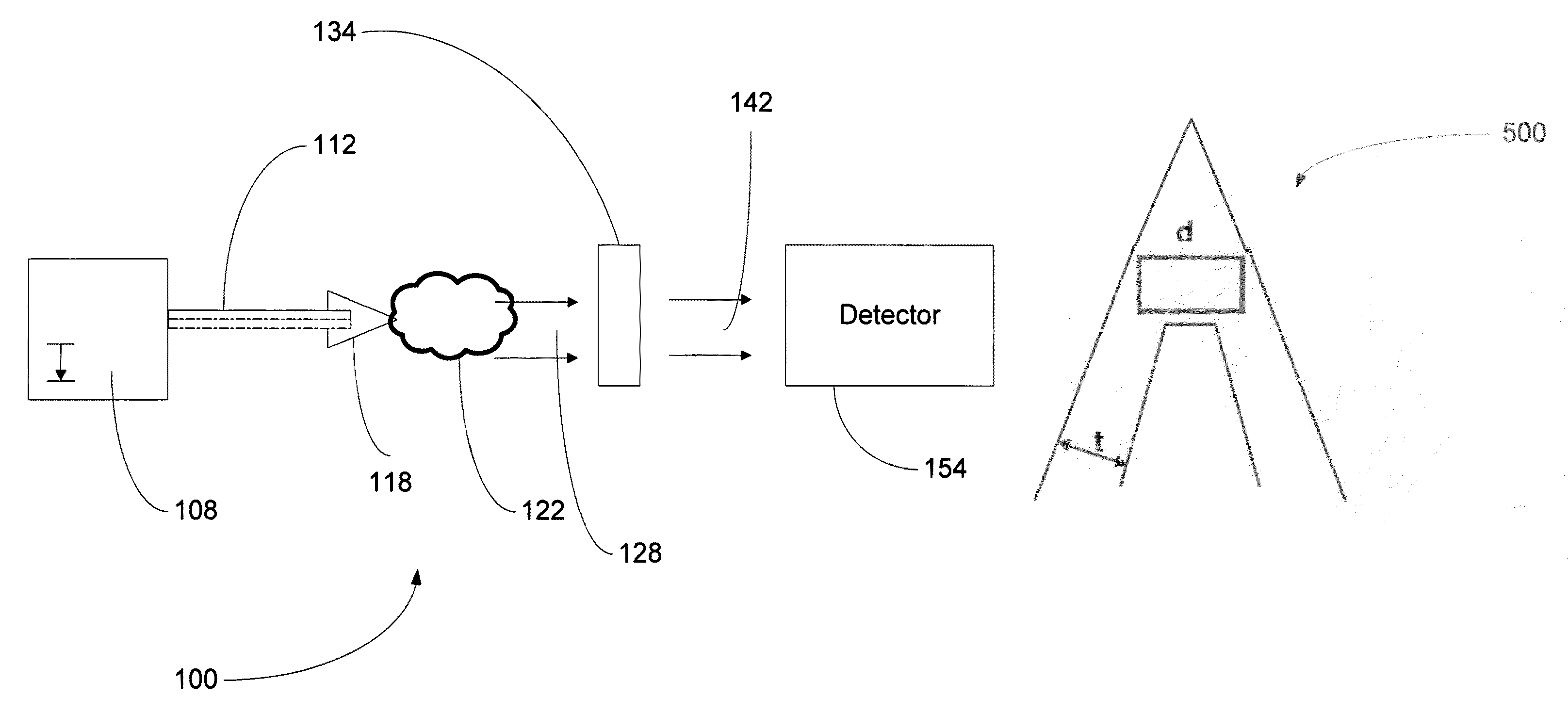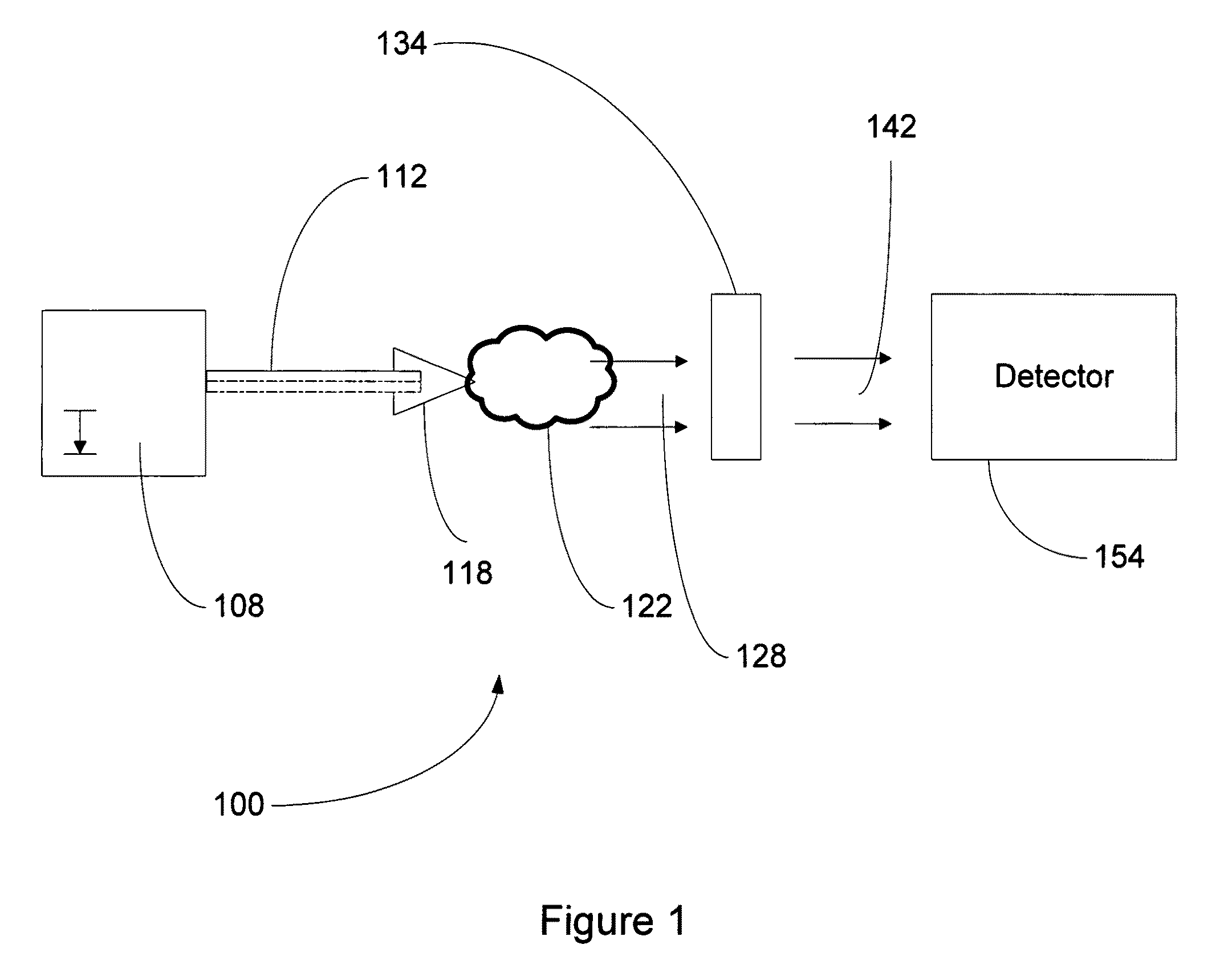Systems and methods for imaging using radiation from laser produced plasmas
a radiation source and plasma technology, applied in the field of targets, can solve the problems of large focal spot, large spectral range, and many image quality limitations
- Summary
- Abstract
- Description
- Claims
- Application Information
AI Technical Summary
Benefits of technology
Problems solved by technology
Method used
Image
Examples
example 1
[0094]A mammography imaging system is set up generally as shown in FIG. 8. The laser is a Ti-Sapph laser having an irradiance of 1·1019 W / cm2, 400 mJ, and a pulse length of 40 fs. The focal spot size is 10 μm. The target is a gold coated, free-standing cone having an internal apex of less than about 1 μm. The thickness of the gold coating is about 10 μm. The target is selected, and the imaging system components selected, to produce k-alpha radiation having energies in the range of 15-25 keV.
[0095]The focal point of the x-ray beam exiting the exit aperture is determined. An x-ray transparent plate is mounted at the focal point of the x-ray beam. In a particular example, a Fuji ST-VA image plate is placed in line with the transparent plate.
[0096]A breast of a patient is exposed and compressed against the x-ray transparent plate. The target is irradiated with the laser. The plate is read using a Fuji FCR-5000 image plate reader. The resulting image is assessed in order to di...
example 2
Phase Contrast Imaging of a Mouse
[0097]A phase contrast imaging system is set up generally as shown in FIG. 1. The laser is a Ti-Sapph laser having an irradiance of 1·1019 W / cm2, 400 mJ, and a pulse length of 40 fs. The focal spot size is 10 μm. The target is a gold coated, free-standing cone having an internal apex of less than about 1 μm. The thickness of the gold coating is about 10 μm. The target is selected, and the imaging system components selected, to produce k-alpha radiation having energies in the range of 10-20 keV. The detector is a PI-SCX CCD camera (Princeton Instruments, Trenton, N.J.) coupled to a Gd2SO2 scintillator optimized for radiation having energies of 10-20 keV.
[0098]The focal point of the x-ray beam exiting the target is determined. The mouse is placed at the focal point of the x-ray beam. The distance between the mouse and the CCD camera is 90 cm.
[0099]The mouse is irradiated with the laser and x-ray phase shift and x-ray absorption are measured. The result...
example 3
Time-Gated Imaging of a Mouse
[0100]An imaging system is set up generally as shown in FIG. 1. The laser is a Ti-Sapph laser having an irradiance of 1·1019 W / cm2, 400 mJ, and a pulse length of 40 fs. The focal spot size is 10 μm. The target is a gold coated, free-standing cone having an internal apex of less than about 1 μm. The thickness of the gold coating is about 10 μm. The target is selected, and the imaging system components selected, to produce k-alpha radiation having energies in the range of 10-25 keV. The detector is a Kentech x-ray streak camera with a time resolution of about 50 ps read out using a La Vision FlameStar IIF CCD camera (LaVision, Inc., Ypsilanti, Mich.), as described in Gratz et al., IEEE J. Sel. Top. Quantum Electron. 2, 1041 (1996), incorporated by reference herein in its entirety.
[0101]The flux of x-rays in the x-ray beam exiting the target is determined. The mouse is placed in a rotating cage at an appropriate point in the x-ray beam. The detector is plac...
PUM
 Login to View More
Login to View More Abstract
Description
Claims
Application Information
 Login to View More
Login to View More - R&D
- Intellectual Property
- Life Sciences
- Materials
- Tech Scout
- Unparalleled Data Quality
- Higher Quality Content
- 60% Fewer Hallucinations
Browse by: Latest US Patents, China's latest patents, Technical Efficacy Thesaurus, Application Domain, Technology Topic, Popular Technical Reports.
© 2025 PatSnap. All rights reserved.Legal|Privacy policy|Modern Slavery Act Transparency Statement|Sitemap|About US| Contact US: help@patsnap.com



